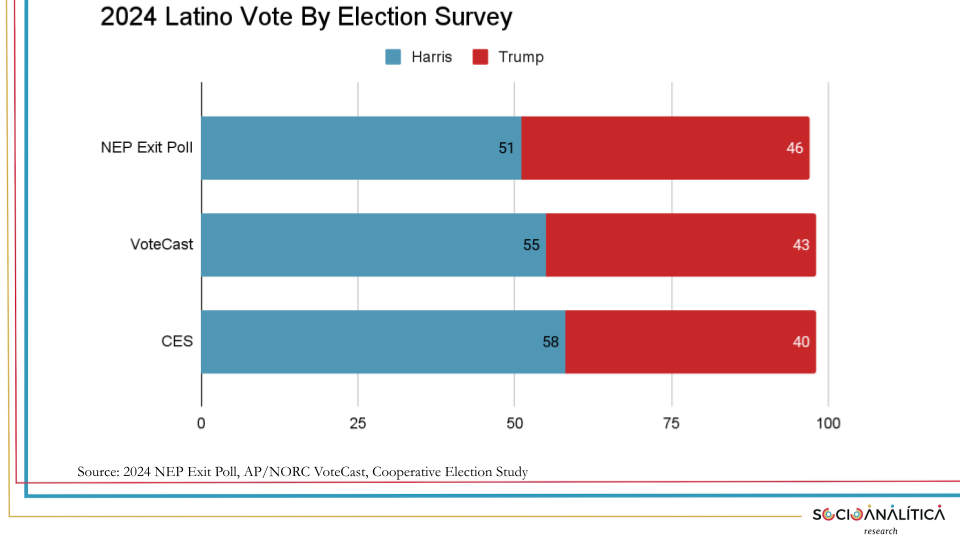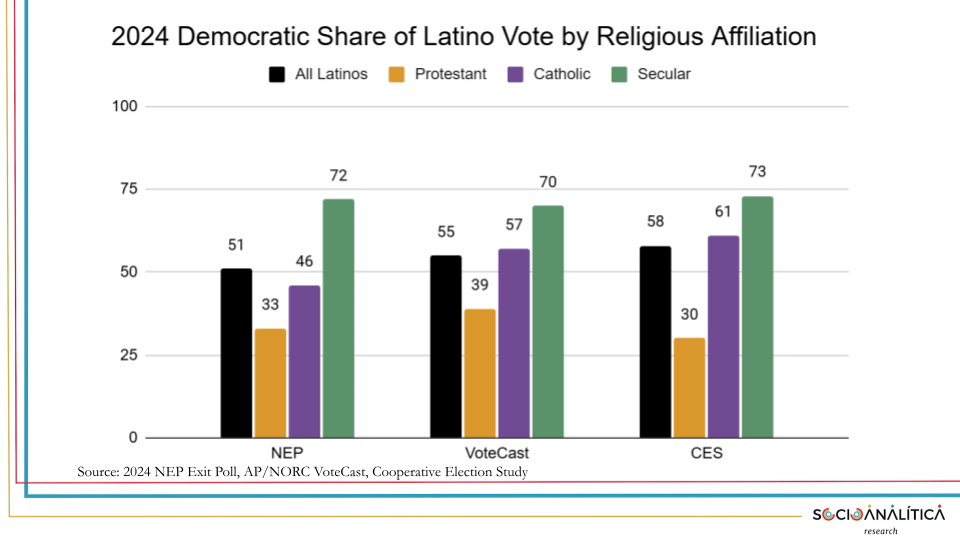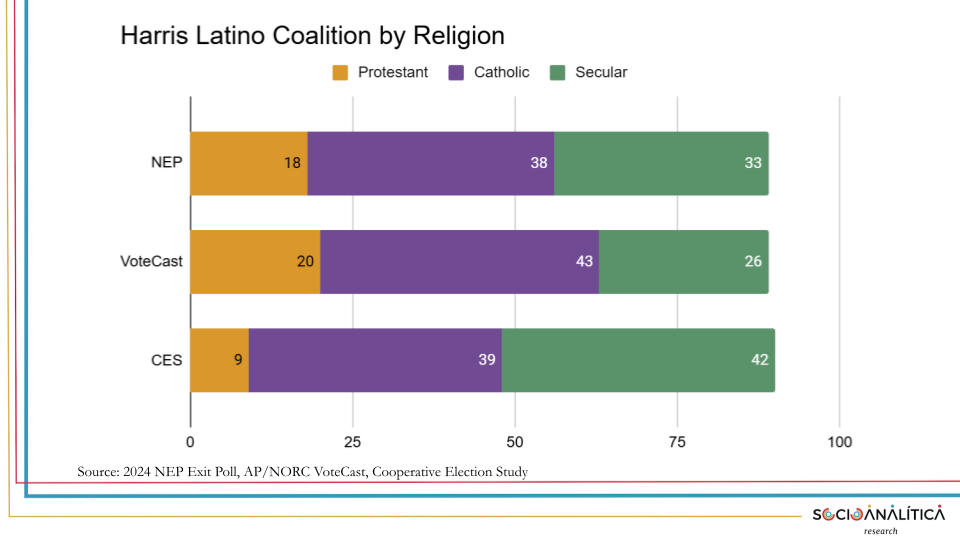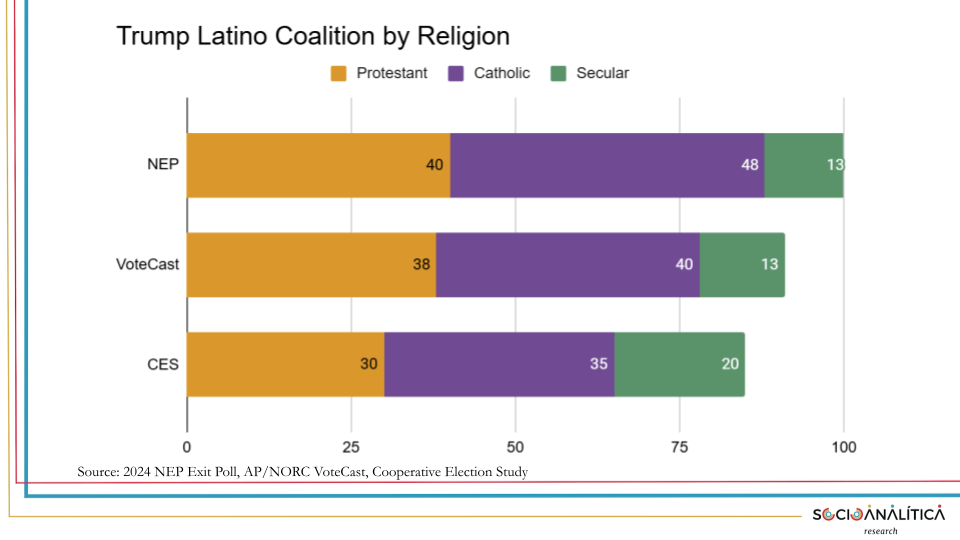Three Perspectives on the Latino Vote
Sep 26, 2025 1:16 pm
We have already explored the demographic characteristics and beliefs of Latinos by religion, with a focus on secular Latinos. Now, I will focus on the 2024 election results of Latino voters by religion. According to three major voter surveys released in 2024, Donald Trump made substantial gains among Latino voters, particularly compared to the 2020 election. Historically, he won the largest share of Latino voters recorded in the 2024 National Election Pool Exit Poll. Two other major surveys that measure election voter results, the AP VoteCast and the CES Cooperative Election Study, also find that the Latino vote moved considerably toward Trump in the last election. Next week, I’ll delve deeper into the shift between 2020 and 2024, but for now, I want to focus on the 2024 election results and the insights provided by these three surveys.
The National Election Pool Exit Poll, which has been around since the 1970s with some methodological changes, recorded that a majority of Latinos supported Harris over Trump by a margin of 51% to 46%. This is historically low; for example, in 2020, 65% of Latinos voted for Joe Biden, while 32% voted for Trump, marking a significant 14-point shift toward Trump. If we look at the vote by religion, the CNN breakdown reveals some noteworthy patterns. Although the dataset was not fully available at the time of this writing, CNN’s tabulation of the exit poll results indicates that the majority of Latino Catholics voted for Trump, with a margin of 53% to 46%. This may be the first time that a Democrat has lost the Latino vote in recorded history, according to this particular survey. Latino Protestants (defined as all Christians that are not Catholic) voted for Trump at a rate of two-to-one (66% to 33%). In contrast, secular Latinos (defined as those who say their religion is “none”) voted for Harris at a rate of 72% to 25%. This aligns with trends observed among secular voters overall.
This observation confirms what I noted back in November when analyzing the secular vote overall: I suggested that secular voters were the only group that did not shift toward Trump. In an earlier piece I wrote this year, I speculated that, based on the available Exit Poll data, Christian Latinos likely moved toward Trump, potentially influenced by Christian nationalist rhetoric.
Moving on to the AP VoteCast, the results showed that Kamala Harris won Latino voters with a stronger majority: 55% to 43% for Trump. Interestingly, the Catholic vote in this survey did not favor Trump; it showed that Catholic Latinos voted for Harris at a rate of 57% to 42%. Protestant/Other Christian Latino voters still favored Trump at 58% to 37%. Secular Latino voters again strongly supported Harris, with 70% to 27%.
The final insights come from the Cooperative Election Study, conducted by various political scientists primarily associated with Harvard University. This survey also found a significant proportion of Latino voters supporting Trump. Using their vote validation weights, it showed that Catholics supported Harris at a rate of 61% to 37%. In contrast, Protestant and other Christian groups supported Trump at a rate of 69% to 30%. Once again, nearly three-quarters of secular Latino voters supported Harris 73% to 25%.
Now, let’s take a look at how the Harris and Trump coalitions among Latino voters differ by religion. Overall, the Exit Poll sample shows that 42% of Latinos identified as Catholic, 28% as Protestant, and 23% as secular. When compared to the stats provided by the Pew Religious Landscape Survey, we find that these numbers align well: about 42% are Catholic, 27% are secular, and 25% are Protestant (with other Christians potentially combined).
Catholics accounted for 38% of Kamala Harris’s vote share among Latino voters, while 18% were Protestant and 33% were secular. Among Trump voters, 48% were Catholic, while 40% were Protestant, and 13% secular Latino voters. However, I suggest we take these figures with a grain of salt, as I’m working from tables from the CNN website. Some of the numbers may not align well, particularly regarding Trump’s support, which could be influenced by how religious questions were formatted and administered in the survey, as it was only asked of a subsample of respondents.
According to VoteCast, the sample is again comprised of 42% Catholics, 28% Protestants, and 20% secular individuals. This suggests a slight underrepresentation of secular voters and overrepresentation of Protestant voters. Based on these numbers, Kamala Harris's coalition would consist of 43% Catholic, 20% Protestant, and 26% secular, whereas Trump’s coalition would have 40% Catholic, 38% Protestant, and 13% secular. Overall, the data indicate that Protestant voters tend to be overrepresented in Trump’s coalition while secular voters are more likely to support Harris.
In the CES, 37% of voters identified as Catholic, 18% as Protestant, and 33% as secular, indicating a slight underrepresentation of Catholics and Protestants and an overrepresentation of secular voters. Harris's coalition consisted of 39% Catholics, 9% Protestants, and 42% secular voters. On the Trump side, 35% identified as Catholic, 30% as Protestant, and 20% as secular. Again, we can see that secular voters are underrepresented among Trump supporters, while Protestants are overrepresented in that coalition.
What do these findings tell us about secularism and religion in the 2024 election? The surveys, which employed different methodologies and were collected at various times, tell a similar-ish story. At least 40% of Latinos in these surveys voted for Trump, while Kamala received a majority of the vote, still significantly lower than Democratic candidates historically. All three surveys indicate that the strongest vote for Harris came from secular voters.
Analysis of the election results showed that at least seven in ten secular voters supported Harris. While the NEP Exit Poll suggests that a majority of Catholics voted for Trump, the CES and VoteCast show majorities of this group voting for Harris, though at lower levels than secular Latinos. Conversely, Protestant voters have strongly leaned toward Trump in all three surveys. Religion is certainly a factor in the Latino vote, one that is often ignored, but as the religious population shrinks and the secular population gains, these differences may become starker in the future.
Secular and Christian Latinos in Presidential Elections
Join me and Sarah Levin on September 30 at 6:00 PM Eastern Time for a discussion about Secular and Christian Latinos in Presidential Elections. Event description below:
Today, nearly three in ten Latinos identify as nonreligious, representing a significant and growing segment of the community. Despite their size and increasing influence, discussions around religion in the Latino community often overlook this group, instead highlighting the diminishing numbers of Catholic and evangelical populations.
This presentation will focus on the changing demographics, beliefs, and electoral impact of secular Latinos. We will discuss how secular Latinos are shaping Latino electoral behavior and attitudes on important social and cultural issues.
Registration here.





